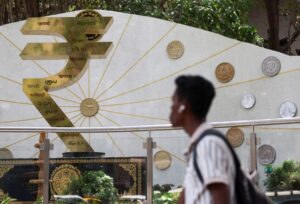Analyzing Goldman Sachs’ Options Play on the Indian Rupee: What You Need to Know
Goldman Sachs has recently made waves with a strategic recommendation regarding the Indian rupee (INR). Investors should pay attention, as this insight could offer lucrative opportunities in the foreign exchange market.
The Recommendation
Goldman Sachs is advocating an options strategy centered on the Indian rupee, specifically suggesting a binary put option on the USD/INR pair with a strike price set at 83. This play hinges on the expectation that the Indian currency will appreciate—targeting a three percent increase from its current value of 85.50 against the U.S. dollar—over the next nine months.
Why the Optimism?
Several factors are contributing to this bullish outlook on the rupee:
-
Macro Economic Stabilization: India’s economic fundamentals are improving, with Gross Domestic Product (GDP) growth accelerating to a robust 7.4% year on year in the last quarter. This marks an increase from the previous quarter’s growth of 6.4%, signaling a resilient economy.
-
Foreign Inflows: There has been a resurgence of foreign equity investments in Indian markets, totaling over $4 billion within the last two months alone. This trend not only enhances market liquidity but also bolsters the appeal of Indian assets to international investors.
-
Lower Oil Prices: As per Goldman’s commodities research, Brent crude is projected to average $60 a barrel through the end of 2025, easing pressure on India’s current account deficit. Given that India is a major oil importer, lower energy costs can significantly bolster the rupee’s strength.
- Potential Trade Deals: The prospect of a U.S.-India trade deal looms large. Analysts suggest that a rollback of reciprocal tariffs imposed on Indian goods would be a major boost for both the rupee and Indian risk assets.
The Binary Put Option Explained
Goldman’s strategy involves purchasing a nine-month binary put option. For those unfamiliar, a binary put option is a financial derivative that pays out a fixed amount if the underlying asset settles below the predetermined strike price at expiration. In this case, if the USD/INR pair falls below 83, the option will yield a profit.
“The nine-month duration is strategic,” notes a Goldman Sachs sales report. Historically, the rupee has shown a tendency to appreciate towards India’s financial year-end, which concludes on March 31. This intuitive timing provides investors an advantageous window for executing the recommended strategy.
Consumption Trends and Future Outlook
Goldman Sachs’ monthly activity tracker indicates that consumer sentiment remains strong, with robust consumption rates reported in April. This continued purchasing activity is vital for sustaining economic growth and fostering currency stability.
Cautionary Notes
While there are promising indicators, investors should remain aware of potential headwinds. The ongoing tariffs and trade negotiations introduce an element of uncertainty that could impact the rupee’s trajectory. The U.S. had previously proposed significant levies on Indian imports, which have been deferred until July 8, granting investors a temporary reprieve from disruption.
Conclusion
The recommendation from Goldman Sachs to engage in a put option on the Indian rupee underscores a noteworthy shift in the currency’s outlook, anchored in improving economic fundamentals and potential geopolitical shifts. For investors, this strategy provides a compelling opportunity to capitalize on what could be a transformative period for the Indian economy.
At Extreme Investor Network, we are committed to distilling complex financial information into actionable insights. Keep an eye on the evolving landscape of the Indian currency market, leveraging expert analysis to navigate your investment journey smartly.

